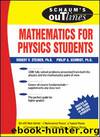Schaum's Outline of Mathematics for Physics Students (Schaum's Outline Series) by Steiner Robert & Schmidt Philip

Author:Steiner, Robert & Schmidt, Philip [Steiner, Robert]
Language: eng
Format: mobi
Publisher: McGraw-Hill/TAB Electronics
Published: 2007-04-23T16:00:00+00:00
The direction of the torque is mutually perpendicular to the directions of the force and the lever arm. Using the right-hand rule described above, it is mutually perpendicular to both the force vector and the lever arm in the direction indicated in Fig. 18-16.
Fig. 18-16
EXAMPLE 12. Find the motion of a proton moving at 2× 106m/s in a uniform magnetic field of 1 T when:
(a) the proton velocity is parallel to the field;
(b) the proton velocity is perpendicular to the field; and
(c) the proton velocity is traveling at an angle of 37° with respect to the field.
The force acting on a charged particle in a uniform magnetic field is given by the formula where the force is given in newtons (N), the particle charge q is given in coulombs (c) and the magnetic field is given in teslas (T). The magnitude of the magnetic force is therefore F = qv B sin θ where θ is the angle between the velocity vector of the proton and the direction of the magnetic field. See Fig. 18-15.
*As pictured inFig. 18-16, the lever arm vector with a magnitude equal to the distance from the center of the bolt(in m) and a direction along its axis extending from the center of the bolt to the point at which the force is applied.
For (a): Because the proton is traveling parallel to the field, θ is 0 and therefore F = qv B sin θ = qv B sin 0 = 0. Because no force acts upon the particle, it will move—according to Newton's First Law—in a straight line at the indicated velocity of 2 106m/s.
For (b): In this case, because the proton is traveling perpendicular to the field, θ is 90° and therefore F = qv B sinθ = qv B sin 90° = qv B(1) = qv B. The direction of the force is always perpendicular to the particle motion and the magnetic field; one can convince oneself that this results in uniform circular motion of the particle.
One can go further by using the physics of uniform circular motion, combining the centripetal force relation F = mv2/r with the magnetic force law F = qv B to find an expression for the radius of the circle: r = mv/qB. Using the known values of the proton mass and charge and the given values of the other quantities, we get
Download
This site does not store any files on its server. We only index and link to content provided by other sites. Please contact the content providers to delete copyright contents if any and email us, we'll remove relevant links or contents immediately.
The Complete Stick Figure Physics Tutorials by Allen Sarah(7135)
Secrets of Antigravity Propulsion: Tesla, UFOs, and Classified Aerospace Technology by Ph.D. Paul A. Laviolette(4974)
Thing Explainer by Randall Munroe(3782)
The River of Consciousness by Oliver Sacks(3414)
The Order of Time by Carlo Rovelli(3072)
How To by Randall Munroe(2911)
I Live in the Future & Here's How It Works by Nick Bilton(2840)
A Brief History of Time by Stephen Hawking(2819)
What If?: Serious Scientific Answers to Absurd Hypothetical Questions by Randall Munroe(2542)
The Great Unknown by Marcus du Sautoy(2532)
Midnight in Chernobyl by Adam Higginbotham(2386)
Blockchain: Ultimate Step By Step Guide To Understanding Blockchain Technology, Bitcoin Creation, and the future of Money (Novice to Expert) by Keizer Söze(2379)
Networks: An Introduction by Newman Mark(2264)
The Meaning of it All by Richard Feynman(2213)
Easy Electronics by Charles Platt(2205)
The Tao of Physics by Fritjof Capra(2164)
Midnight in Chernobyl: The Untold Story of the World's Greatest Nuclear Disaster by Adam Higginbotham(2075)
When by Daniel H Pink(2020)
Introducing Relativity by Bruce Bassett(2018)
